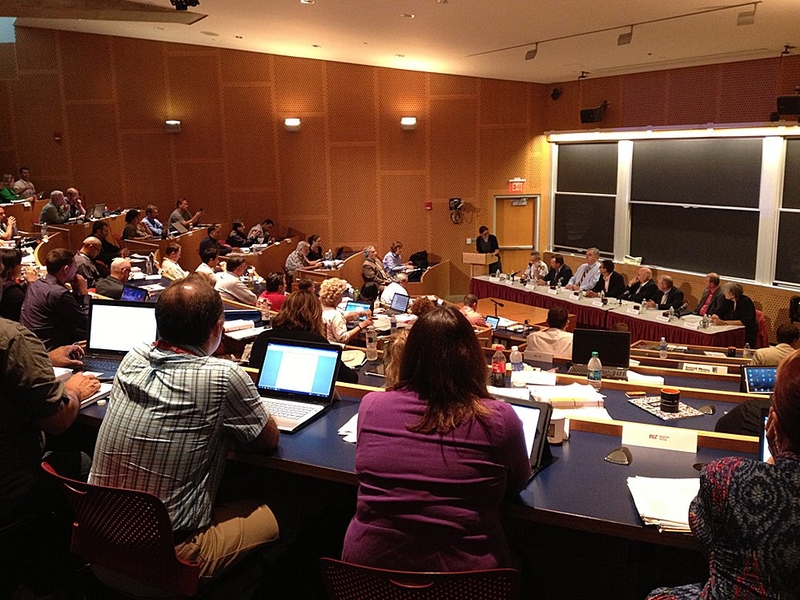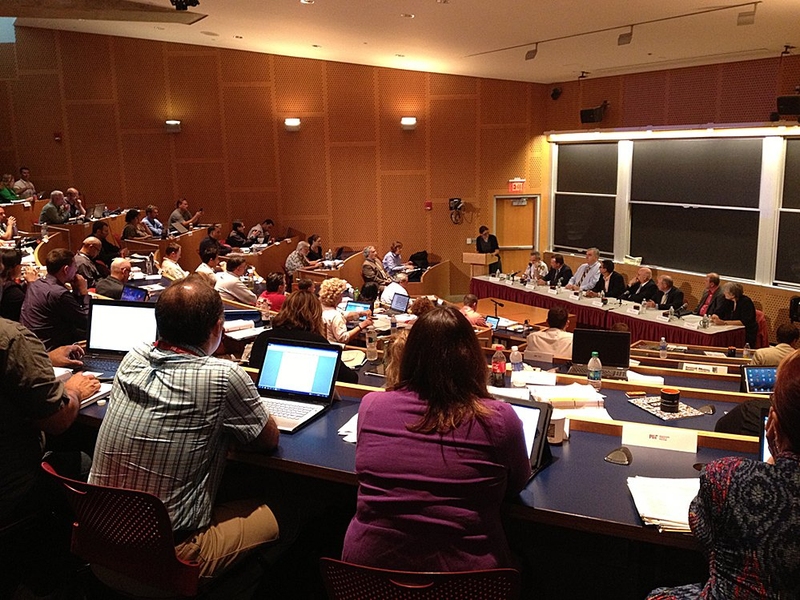While the tragedies of April 15 and April 18, 2013, are forever etched into the minds of the greater-Boston and MIT communities, 46 participants in the MIT Professional Education course Crisis Management and Business Continuity, had the opportunity to hear first-hand accounts of the events on Boylston Street and MIT’s campus from several key responding organizations, news outlets, an MIT alumnus, and several others on July 18 at the Stata Center.
The panel titled “The Boston Marathon bombings: Exemplary response amid horror,” was moderated by WBUR’s Deborah Becker, and included Edward Davis, Boston Police commissioner; James Hooley, chief of Boston EMS; Dr. Paul Biddinger, chief, Division of Emergency Preparedness, medical director, Emergency Department Operations, Massachusetts General Hospital; Imad Mouline, SB ’91, CTO, Everbridge, a Mass and Emergency Notification software company; Joe Sciacca, editor-in-chief of the Boston Herald; and Peter Casey, programming and news director, WBZ radio. William VanSchalkwyk, managing director, Environment, Health, and Safety Headquarters Office, MIT; and Helen Privett, business continuity manager at GMO, were also on hand.
The course, taught by MIT professor Richard Larson, Mitsui Professor of Engineering Systems Director, Center for Engineering Systems Fundamentals; Dr. Steve Goldman a world-renowned expert in crisis communications, disaster recovery and business continuity; and William VanSchalkwyk, managing director, Environment, Health, and Safety Headquarters Office at MIT, covered a variety of material regarding crisis communications, crisis management and business continuity over the five-day course.
“I believe this was the first and only panel of its kind,” Goldman said. “One of the objectives of our Course is to provide our students with a 360-perspective on emergency response, crisis management, and crisis communication. Students in the class heard first-hand accounts of those directly involved with the Boston Marathon bombings’ response. Our students can now take the lessons learned here back to their organizations and apply them.”
Imad Mouline, SB ’91, CTO, Everbridge, a Mass and Emergency Notification software company noted that when he is asked what worked on that tragic day with regards to communication he says “a little bit of everything.”
“You have to communicate in every single stage of a crisis…no matter what crisis model you use. What the message is is absolutely critical,” said Mouline, adding, “It’s part heart and part science.”
“There is actually no 100 percent reliable method of communicating with people 100 percent of the time,” Mouline noted. “So the only approach that’s there is to target the individual.”
The Boston Marathon
“I had never seen anything like that,” Boston Police Commissioner Ed Davis said of the bombings. “We quickly set up a command post. We spent a lot of time planning for the Boston Marathon. We spent a lot of time training for mass casualty events and for terrorism events, but we don’t have a plan for that.”
“There is an important distinction here,” Davis noted. “The plan that we have is in the preparation to handle the marathon. It has contingencies in it to deal with things like explosions. There is no plan that says ‘When the bombs go off do A-B-C.’ You prepare, but can’t definitively plan exactly each step because you don’t know the scope and intensity of the locations of the bombs. As good your plans can be, as the military says, ‘When the plan meets reality, it all changes.’”
Paul Biddinger, M.D., Chief, Division of Emergency Preparedness, Massachusetts General Hospital said of the hospital’s crisis plan, “An enormous amount of our response was built on the fact that we have learned lessons from others.”
When asked what the economic impact to the City of Boston was when the Shelter in Place order was announced, Biddinger said, “The decision came at 6:00 a.m. That meant for the hospital that our night shift was still present and we couldn’t bring in the day shift. That basically meant an entire day’s worth of cancellation. As a back of envelope calculation for one day, for one large health care institution, it was about a $5 million impact for that one day decision.”
At MIT
Bill VanSchalkwyk spoke to the audience about MIT’s response to the shooting of MIT Police Officer Sean Collier and the subsequent “Shelter in Place” order that closed MIT’s campus for the day.
“Our first alert to the community went out in about six-minutes after the shooting happened here. We then sent out messages about every 30 minutes,” said VanSchalkwyk. “We were surprised and pleased with not only the conformance by our home community to stay off the streets but by everybody. Everyone had a sense of duty to do whatever they could to help law enforcement apprehend these perpetrators. The MIT campus is very strong.”
"I’m struck by expression of ‘Boston Strong’,” said VanSchalkwyk. “Here on this campus the expression is generally, ‘Collier Strong.’ I’d say the community looks out for each other a lot more than they have been. We are much more linked together in terms of taking care of one another.”
All the panelists agreed that not only planning, but testing crisis plans, filling in missing information and holes, and re-testing, communicating with their organizations via social media, texting, and email, is key to a successful communication and outcomes.
Bhaskar Pant, executive director of MIT Professional Education, added, “We’re thrilled that professionals from around the world enrolled in this course were able to hear from both experts here at MIT and in Boston about an event that garnered world attention. The students can apply what they learned not only from this distinguished panel, but from the entire Crisis Management and Business Continuity course, immediately to their jobs and with other stakeholders in their organizations.”
The panel titled “The Boston Marathon bombings: Exemplary response amid horror,” was moderated by WBUR’s Deborah Becker, and included Edward Davis, Boston Police commissioner; James Hooley, chief of Boston EMS; Dr. Paul Biddinger, chief, Division of Emergency Preparedness, medical director, Emergency Department Operations, Massachusetts General Hospital; Imad Mouline, SB ’91, CTO, Everbridge, a Mass and Emergency Notification software company; Joe Sciacca, editor-in-chief of the Boston Herald; and Peter Casey, programming and news director, WBZ radio. William VanSchalkwyk, managing director, Environment, Health, and Safety Headquarters Office, MIT; and Helen Privett, business continuity manager at GMO, were also on hand.
The course, taught by MIT professor Richard Larson, Mitsui Professor of Engineering Systems Director, Center for Engineering Systems Fundamentals; Dr. Steve Goldman a world-renowned expert in crisis communications, disaster recovery and business continuity; and William VanSchalkwyk, managing director, Environment, Health, and Safety Headquarters Office at MIT, covered a variety of material regarding crisis communications, crisis management and business continuity over the five-day course.
“I believe this was the first and only panel of its kind,” Goldman said. “One of the objectives of our Course is to provide our students with a 360-perspective on emergency response, crisis management, and crisis communication. Students in the class heard first-hand accounts of those directly involved with the Boston Marathon bombings’ response. Our students can now take the lessons learned here back to their organizations and apply them.”
Imad Mouline, SB ’91, CTO, Everbridge, a Mass and Emergency Notification software company noted that when he is asked what worked on that tragic day with regards to communication he says “a little bit of everything.”
“You have to communicate in every single stage of a crisis…no matter what crisis model you use. What the message is is absolutely critical,” said Mouline, adding, “It’s part heart and part science.”
“There is actually no 100 percent reliable method of communicating with people 100 percent of the time,” Mouline noted. “So the only approach that’s there is to target the individual.”
The Boston Marathon
“I had never seen anything like that,” Boston Police Commissioner Ed Davis said of the bombings. “We quickly set up a command post. We spent a lot of time planning for the Boston Marathon. We spent a lot of time training for mass casualty events and for terrorism events, but we don’t have a plan for that.”
“There is an important distinction here,” Davis noted. “The plan that we have is in the preparation to handle the marathon. It has contingencies in it to deal with things like explosions. There is no plan that says ‘When the bombs go off do A-B-C.’ You prepare, but can’t definitively plan exactly each step because you don’t know the scope and intensity of the locations of the bombs. As good your plans can be, as the military says, ‘When the plan meets reality, it all changes.’”
Paul Biddinger, M.D., Chief, Division of Emergency Preparedness, Massachusetts General Hospital said of the hospital’s crisis plan, “An enormous amount of our response was built on the fact that we have learned lessons from others.”
When asked what the economic impact to the City of Boston was when the Shelter in Place order was announced, Biddinger said, “The decision came at 6:00 a.m. That meant for the hospital that our night shift was still present and we couldn’t bring in the day shift. That basically meant an entire day’s worth of cancellation. As a back of envelope calculation for one day, for one large health care institution, it was about a $5 million impact for that one day decision.”
At MIT
Bill VanSchalkwyk spoke to the audience about MIT’s response to the shooting of MIT Police Officer Sean Collier and the subsequent “Shelter in Place” order that closed MIT’s campus for the day.
“Our first alert to the community went out in about six-minutes after the shooting happened here. We then sent out messages about every 30 minutes,” said VanSchalkwyk. “We were surprised and pleased with not only the conformance by our home community to stay off the streets but by everybody. Everyone had a sense of duty to do whatever they could to help law enforcement apprehend these perpetrators. The MIT campus is very strong.”
"I’m struck by expression of ‘Boston Strong’,” said VanSchalkwyk. “Here on this campus the expression is generally, ‘Collier Strong.’ I’d say the community looks out for each other a lot more than they have been. We are much more linked together in terms of taking care of one another.”
All the panelists agreed that not only planning, but testing crisis plans, filling in missing information and holes, and re-testing, communicating with their organizations via social media, texting, and email, is key to a successful communication and outcomes.
Bhaskar Pant, executive director of MIT Professional Education, added, “We’re thrilled that professionals from around the world enrolled in this course were able to hear from both experts here at MIT and in Boston about an event that garnered world attention. The students can apply what they learned not only from this distinguished panel, but from the entire Crisis Management and Business Continuity course, immediately to their jobs and with other stakeholders in their organizations.”







